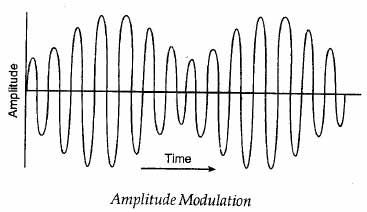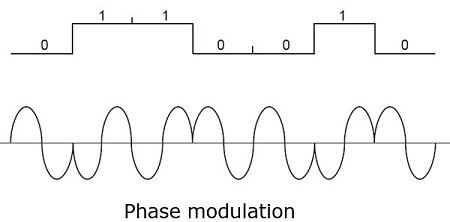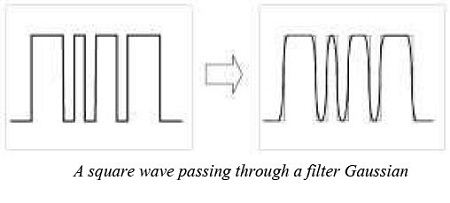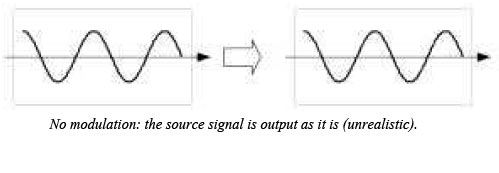We’ll be covering the following topics in this tutorial:
The basic modulations
No modulation
Take the example of an opera broadcast on a radio station: how music, that is to say, an audio signal, it may be channeled through wave electromagnetic? Audible sound waves have frequencies between 20 Hz to 20 kHz for bass and treble. It would be tempting to simply convert the sound wave in radio waves of the same frequency. Unfortunately, there would be several problems: first, the low radio frequencies also are very difficult to produce and capture; then two simultaneous radios would overlap since they would be issued on the same frequency band (20 Hz to 20 kHz) and would cacophony.
Amplitude modulation
To solve this problem, one solution is to emit a radio wave fixed frequency, the so-called wave “carrier”, which is modified in amplitude function of the sound wave, which is the wave “source”: the amplitude modulation (Amplitude Modulation, AM). Source is said that the wave “module” the carrier wave, this is possible only if the carrier has a much higher frequency than the wave source. The advantage is that one can then choose the frequency that is preferred for the carrier signal, which allows transmitting several programs simultaneously on different frequencies. The receiver has to select a “channel”, that is to say, a frequency to “demodulate” to select the program that he prefers. This is what you made when selecting an AM radio on your stereo.
 Frequency modulation
Frequency modulation
Conversely, it can emit a radio wave of fixed amplitude, but whose frequency varies within a given frequency band, in proportion to the source signal. This is called the FM (Frequency Modulation, FM).

Each modulation has advantages and disadvantages:
• The AM is simpler to implement technically and she is the first to have emerged. It occupies a very small frequency band: theoretically a single frequency communication, but in practice rather few kHz to avoid interference between neighboring channels.
• For its part, the FM needs a fairly broadband: several tens of kHz for a radio station, for example.
• FM can be used for very low power while AM needs more power for it is that which is modulated by the signal source.
• Symmetrically, the AM can be satisfied with a carrier wave frequency low enough so that the FM requires higher frequencies.
• The FM is much less sensitive to distortions due to power obstacles or interference since the variations of the signal strength are not taken into account by the receiver during the demodulation. You will realize if you listen to FM radio during a drive in town: unless you go through a tunnel, the sound volume will remain constant. But if you listen to AM radio, you will sometimes hear drops volume depending on the quality of reception.
All this explains why the PM is preferred for long communications distance (low frequency and high power) and FM is preferred for transmissions Urban (better resistance to interference). This comparison aims to show you how the choice of modulation may impact the range and throughput of a transmission.
Phase modulation
The phase of a wave is its position in time, if two waves of the same frequency are in phase, then their amplitude peaks are simultaneous. They are antiphase when the peaks of one correspond to the valleys of the other. We Phase measurement in degrees: two waves have no phase shift, that is to say a phase equal to 0◦. Two waves in phase opposition a 180◦ offset. it is possible to modulate the phase depending on the source signal, what is simply called phase modulation (Phase Modulation, PM).
Digital modulations
Simple modulations: ASK, FSK and PSK
When one wishes to transmit digital information (0’s and 1, it can UA ie information bits) rather than an analog source (such as a wave sound), can be used modulations AM, FM or PM. This is called “coding” (Keying).
For AM, there will be just two possible amplitudes, one symbolizing 0 and the other the 1. This is called the Amplitude-Shift Keying (ASK), that is to say, “coding by amplitude shift”. This modulation is unfortunately sensitive to noise and interference.
Similarly, FM, a given frequency will be issued to symbolize the 0 and another for 1. This is called Frequency-Shift Keying (FSK) is a technique used by the WiFi as we shall see in the following paragraphs.
In phase modulation, we can choose a 0◦ phase to code 0 or 180◦ to code 1. This is called Phase-Shift Keying (PSK).
Differential modulations DPSK
Another technique is to take into account the variation of phase and not the phase in the absolute: no phase change means “0”; a change 180◦ means of “1”. This is the Differential PSK (DPSK). Could also apply the same logic to the ASK and FSK.
Unfortunately, differential modulations are often less efficient in noisy environments because they introduce a new possible source of error: the offset of the previous signal is in addition to that of the current signal. For example, PSK simple, if the signals transmitted successively to 0◦ phase but 0◦ and 180◦ the receiver receives 0◦, 120◦ and 40◦, it will “round” with the possible values closest (0◦ or 180◦) and return to good result. In contrast, with the same scenario, in DPSK, while the transmitter sent two transitions 180◦ each, the receiver will see a transition 120◦ (rounded 180◦) and a -80◦ (rounded to 0◦).
The advantage of differential modulations is that they are simpler to out that “absolute” systems: the receiver can indeed be calibrated at any moment on the last signal received.
Multi-bit symbols: QPSK, QAM …
We can go further with the PSK choosing four possible phases rather two (the reasoning is identical for the other modulations). These four phases will then have the following meanings bits: 00, 01, 10 and 11. It can therefore transmit couples by information bits, which doubles naturally flow. This technique is called Quadrature PSK (QPSK or 4PSK).
Bit groups are called “symbols” or “samples” (sample). One can therefore measure the flow rate in symbols per second. For example, a flow 1 Ms / s (mega symbol per second) with symbols of 2 bits corresponds course at a rate of 2 Mb / s. Also referred baud with 1 baud = 1 symbol / second.
PSK may be combined with the amplitude modulation to encode more of information bits in each symbol. This technique is called Quadrature Amplitude Modulation (QAM). May for example have four possible phases (Or phase transitions with the DPSK) and two possible amplitudes to each phase. In this case, there will be eight possible combinations, 3 information bits for each transmitted symbol (because 23 = 8): this is called 8QAM. As we shall see, for the higher rates, the WiFi is based on the 16QAM (twelve possible phases including four for which two amplitudes are possible) with 4 bits of information per symbol, or even 64QAM with 6 bits per symbol! The QAM however, requires quite sophisticated equipment.
Gaussian filter: GFSK
Another fairly complex modulation technique involves passing the source bit through a Gaussian filter prior to modulating the carrier. Before the passage in the filter source has two states (0 and 1) and the transitions between these states are brutal: in other words, the signal is “square”. After passing through the filter, the source signal is “softened” transitions are less brutal. It comes in a way to spread each bit and do spill over its neighbor.

Then any modulation can be applied to this source softened such as FSK, for example: it is called Gaussian FSK, GFSK noted.
Without the Gaussian filter, brutal state transitions cause the appearance harmonic frequencies in the transmitted signal. This result in spread the spectrum occupied by the signal and therefore causes interference with neighboring channels. With GFSK, the state transitions are softened, limiting considerably overflow signal outside the selected frequency band.
There is a direct relationship between the number of bits per second of the source (That is to say, its flow) and the width of the main band of the signal: the greater the flow, the more the state transitions are common, so the more harmonics are numerous and the signal spectrum is spread. With FSK and PSK or QAM, the width of the main band is approximately equal to Dual Flow: for example, a flow rate of 11 Mb / s, the main band occupies 22 MHz. This spread spectrum can be interesting, because as we have seen, it helps to resist noise. We will see that the DSSS based on this principle. Depending on the context, it may be useful to “condense” the signal on a narrow canal, or rather to spread it over a wide spectrum.
Pulse modulations
A final type of digital modulation is to issue regular pulses and the shift in time depending on the source signal. Time is divided into slices of fixed duration and during each time slot a short pulse is issued, well below that of the slice length. The module source signal the position of the pulse in the slice. For example, it may be appropriate if pulse occurs at the beginning of the section, this corresponds to bit 0 and if it is at the end, this is the bit 1.
Rather than changing the position of the pulse in time, it is also possible to change its duration, amplitude, etc. A combination of these modulations is also possible.
Infrared physical layer defined by 802.11 is based on the modulation of pulse position, but given that the infrared layer is not used, we will not detail this more modulation.
Comparison of modulations
The different modulations that we have seen have not all the same features:
• PSK and its variants achieve very high data rates, but they “Overflow” on neighboring channels, so the inter-channel interference (Inter-Carrier Interference ICI) are to be feared;
• The 2PSK offers a lower rate than the 4PSK himself slower than 8PSK and so on;
• However, the 2PSK is less sensitive to noise than the 4PSK himself less sensitive as 8PSK, etc.;
• The 64QAM is 1.5 times faster than the 16PSK and is also resistant to noise, but it requires a more complex equipment;
• The DPSK is slightly less efficient than the PSK but simpler to implemented;
• The GFSK is slower than PSK, but it is less sensitive to noise;
• The GFSK overflows very little of the frequency band it uses, which makes it very effective when several neighboring channels are used simultaneously.
It is now time to address the modulations of WiFi, which are based on modulations that we just saw. They are three in number:
• Frequency Hopping Spread Spectrum (FHSS)
• Direct Sequence Spread Spectrum (DSSS)
• Orthogonal Frequency Division Multiplexing (OFDM).
FHSS is only used in the first version of the 802.11 standard. 802.11a based exclusively on OFDM, 802.11b DSSS and exclusively on 802.11g uses DSSS and OFDM, depending on the desired flow rate. 802.11n based on OFDM only when the rule on a channel at 5 GHz, and the DSSS or OFDM 2.4GHz.

 Dinesh Thakur holds an B.C.A, MCDBA, MCSD certifications. Dinesh authors the hugely popular
Dinesh Thakur holds an B.C.A, MCDBA, MCSD certifications. Dinesh authors the hugely popular